Text
I need the weather to get warmer soon so I can go out herping❕❕❕
That damn groundhog was duped or something
5 notes
·
View notes
Text
Alligator Body Language and You, or: How To Know When An Alligator On Social Media is Being Stressed for Views
Alligators are wild animals. Despite the idiotic claims of animal abusers like Jay Brewer, they cannot be domesticated, which means they are always going to react on the same natural instincts they've had for millions of years. Habituated, yes. Tamed, yes. Trained, definitely. Crocodilians can form bonds with people- they're social and quite intelligent. They can solve problems, use tools, and they're actually quite playful. Alligators are also really good at communicating how they're feeling, but to somebody who doesn't spend much time around them, their body language can be a bit mystifying. And it doesn't help when social media influencers are saying shit like this:

That is not what a happy gator looks like.
That's a terrified, furious gator who isn't attacking because the ogre handling her has her in a chokehold. She's doing everything she can to express her displeasure, and he's lying about it because he knows his audience doesn't even know how to think critically about what he's doing. He knows that because his audience doesn't know anything about these animals, he can get away with it. This I think is why I hate him so much- he deliberately miseducates his audience. He knows what he's doing is factually inaccurate, he just doesn't care because attention means more to him than anything else in the world.
Let's change that! Here are two really important lessons for understanding alligator body language on social media.
Lesson 1: Alligators Don't Smile (in fact, most animals don't)
So what's going on in this video? Jay Brewer is aggressively choking his white alligator Coconut while scrubbing algae off of her with a toothbrush. And make no mistake, he is digging into the creature's throat while she is visibly distressed. He claims she's happy- but she's not. He is willfully misrepresenting what this animal is feeling. That's a problem, because people... well, we actually kind of suck at reading other species' body language. The reason for this is that we tend to overlay our own responses on their physical cues, and that's a problem. For example, let's look at an animal with a really similar face to ours, the chimpanzee. Check out Ama's toothy grin!
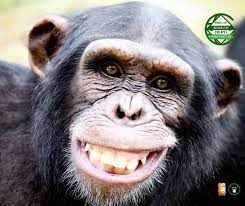
Wait, no. That's not a happy smile. That's a threat display. When a chimpanzee "smiles," it's either terrified and doing a fear grimace, or it's showing you its teeth because it intends on using them in your face.
How about a dog? Look at my smiling, happy puppy!

Oh wait no, this is a picture of Ryder when he was super overwhelmed by noise and people during a holiday party. He'd hopped up in my sister's lap to get away from stuff that was happening on the floor and was panting quite heavily. See the tension in the corners of his mouth and his eyes? A lot of the time when a dog "smiles," the smile isn't happy. It's stress! Why Animals Do The Thing has a nice writeup about that, but the point is, our body language is not the same as other species. And for reptiles, body language is wildly different.
For instance, look at these two alligators. Pretty cute, right? Look at 'em, they're posing for a Christmas card or something! How do you think they're feeling?

Well, I'll tell you how the normal one is feeling. He's annoyed! Why is he annoyed? Because the albino just rolled up, pushed another gator off the platform, and is trying to push this guy, too. I know this because I actually saw it happen. It was pretty funny, not gonna lie. He's not gaping all the way, but he was hissing- you can actually see him getting annoyed in the sequence I took right before this shot. Look at him in this first shot here- he's just relaxing, and you can see he isn't gaping even a little bit.


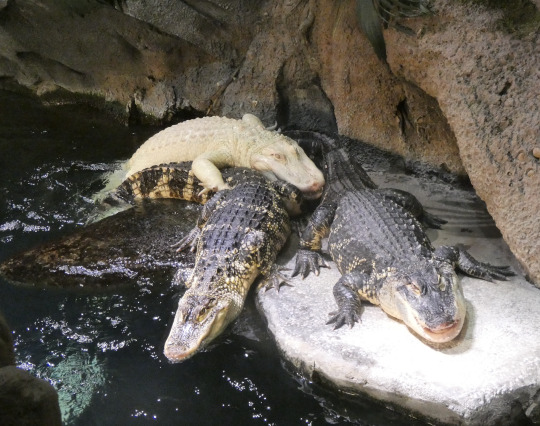
By the end, he's expressing displeasure, but not enough to actually do anything about it. He's annoyed, but he's comfy and that's where one of the best basking areas is, so he'll put up with it.
Reptiles open their mouths wide for a lot of reasons, but never because they are actively enjoying a sensation. Unless they're eating. No reptile smiles- they can't. They don't even have moveable lips. If a reptile is gaping, it's doing so because:
It is doing a threat display.
It is making certain vocalizations, all of which are threats. Alligators are one of the rare reptiles that do regularly vocalize, but most of their calls aren't made with a wide open mouth.
It is about to bite something delicious or somebody stupid. Check out this video- virtually all of the gaping here is anticipatory because these trained gators know darn well that the bowl is full of delicious snacks. (I have some issues with Florida's Wildest, but the man knows how to train a gator AND he is honest about explaining what they're doing and why, and all of his animals are healthy and well-cared for, and he doesn't put the public or his staff at risk- just himself.)
youtube
It's too hot and it has opened its mouth to vent some of that heat and thermoregulate. This is the main reason why alligators will often have their mouths part of the way open, but sometimes they'll open all the way for thermoregulation. This is what a thermoregulatory gape looks like- usually it's not all the way open, kinda more like < rather than V, but you can't say that 100% of the time. Additionally, a thermoregulatory gape... typically happens when it's hot out. If they're inside, maybe they've been under their basking light for too long. Heat's the dominant factor, is what I'm getting at.
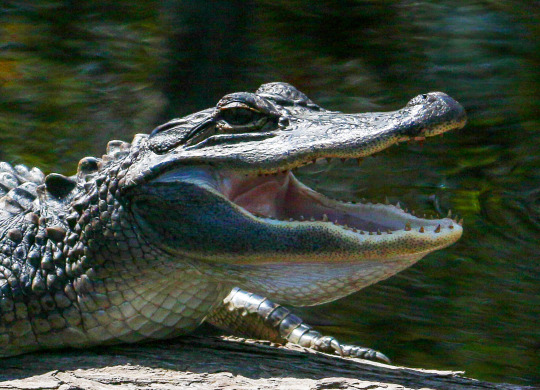
There is another reason that a captive crocodilian might be gaping, and that's because it's doing so on command. Some places have their gators trained to gape on cue, like St. Augustine Alligator Farm and other good zoos. They have the animals do this in presentations that are genuinely educational. They ask the animals to open their mouths so that they can show off their teeth and demonstrate how their tongues seal off the back of their mouth. They'll also do it as part of routine healthcare, because looking at their teeth is important.
In this case, the animals aren't gaping because they're stressed, they're gaping because they know they're gonna get a piece of chicken or fish if they do it. And what's more, they're doing it on cue. They have a specific command or signal that tells them to open wide. It's not an instinctive response to a situation. It's trained. If the animal provides the behavior after a cue, the situation is much less likely to be negatively impactful.
It's also important to remember that there's a difference between a partially open mouth and a gape! As discussed above, alligators will often have their mouths a little bit open just to maintain temperature homeostasis. It helps them stay comfy, temperature-wise. These guys are all doing thermoregulatory open-mouthed behavior- that slight open and relaxed body posture is a dead giveaway. (That and it's the hottest spot in the enclosure.)
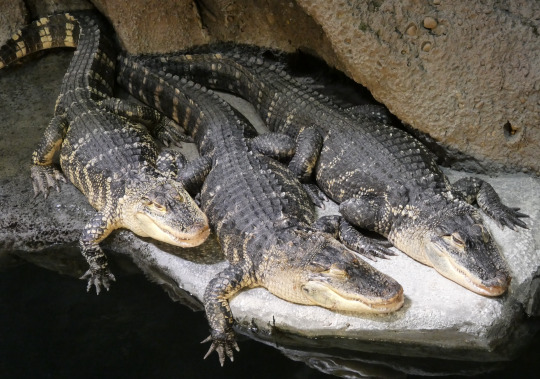
Lesson 2: A Happy Gator Is A Chill Gator
So if alligators don't smile or have facial expressions other than the :V that typically signifies distress, how else can you tell how they're feeling? One way is stillness. See, alligators subscribe to the philosophy of if it sucks... hit da bricks.
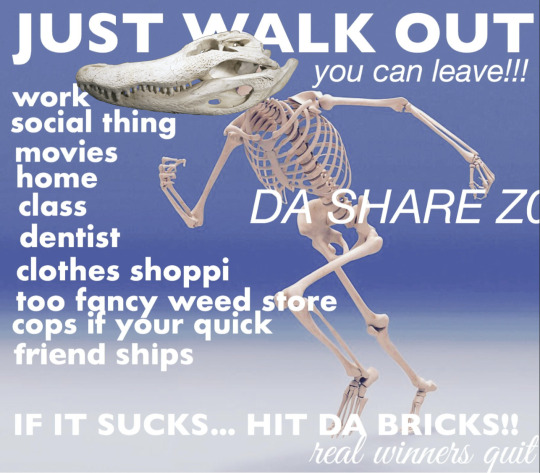
Basically, if they hate it, they'll leave. Unless, y'know, somebody has their meaty claws digging into their throat or is otherwise restraining them. (Restraint isn't always bad, btw. Sometimes the animal is going through a medical thing or needs to be restrained for their safety- which a responsible educator will explain.)
Let's look at a very similar scenario, in which a captive alligator is getting his back scrubbed.
As you can see, it's quite different. First, he's not being restrained at all. Second, look at how relaxed he is! He's just chilling there vibing! He could simply get up and leave if he wanted to, because he's not being held. Towards the end of the video, as he lifts his head, you can see that his respiratory rate is very even as his throat flutters a bit. I'm not sure what this facility is, so I can't comment on care/general ethics, but like. In this specific case, this is an alligator enjoying being scrubbed! And you can tell because he's not doing anything. A happy gator is content to be doing what they're doing.
Why Should I Listen To You?
Now, you should ask yourself, why should you listen to me? Why should you trust me, who does not own an alligator, versus Jay Brewer, who owns several?
Well, first off, there's no profit for me in telling you that what you're seeing on social media is in fact not what you're being told you're seeing. I'm not getting paid to do this. That's the thing with people who make social media content. The big names aren't doing it just for fun. They're doing it for money. Whether that's profit through partnerships or sponsorships, or getting more people to visit their facilities, or ad revenue, you can't ignore the factor of money. And this is NOT a bad thing, because it allows educators to do what they're passionate about! People deserve to be paid for the work that they do!
But the problem starts when you chase the algorithm instead of actually educating. A "smiling" alligator gets the views, and if people don't know enough to know better, it keeps getting the views. People love unconventional animal stories and they want those animals to be happy- but the inability to even know where to start with critically evaluating these posts really hinders the ability to spread real information. Like, this post will probably get a couple hundred notes, but that video of Coconut being scrubbed had almost 400,000 likes when I took that screenshot. Think about how many eyeballs that's reached by now. What I'm saying here is that it's just... really important to think critically about who you're getting your information from. What do dissenters say in the comments? What do other professionals say? You won't find a single herpetologist that has anything good to say about Prehistoric Pets, I can tell you that right now.
Another reason you can trust me is that my sources are not "just trust me bro," or "years of experience pretending my pet shop where animals come to die is a real zoo." Instead, here are my primary sources for my information on alligator behavior:
Dragon Songs: Love and Adventure among Crocodiles, Alligators, and Other Dinosaur Relations- Vladimir Dinets
The Secret Social Lives of Reptiles- J. Sean Doody, Vladimir Dinets, Gordon M. Burghardt
Social Behavior Deficiencies in Captive American Alligators (Alligator mississippiensis)- Z Walsh, H Olson, M Clendening, A Rycyk
Social Displays of the American Alligator (Alligator mississippiensis)- Kent Vliet
Social Signals and Behaviors of Adult Alligators and Crocodiles- Leslie Garrick, Jeffery Lang
Never smile at a crocodile: Gaping behaviour in the Nile crocodile at Ndumo Game Reserve, South Africa- Cormac Price, Mohamed Ezat, Céline Hanzen, Colleen Downs (this one's Nile crocs, not American alligators, but it's really useful for modeling an understanding of gape behaviors and proximity)
Thermoregulatory Behavior of Captive American Alligators (Alligator mississippiensis)- Cheryl S. Asa, Gary D. London, Ronald R. Goellner, Norman Haskell, Glenn Roberts, Crispen Wilson
Unprovoked Mouth Gaping Behavior in Extant Crocodylia- Noah J. Carl, Heather A. Stewart, Jenny S. Paul
Thank you for reading! Here's a very happy wild alligator from Sanibel for your trouble.

#herpetology#herpetofauna#herptiblr#herptiles#reptiblr#reptiles#crocodilians#animal education#reptile welfare#rebog
32K notes
·
View notes
Text
Environmental Enrichment For Reptiles ; What? Why? and How...?
Environmental enrichment (EE) for animals in captivity is not a new concept, and the benefits of EE on an animals psychological and physiological well being is well documented. However, less attention seems to have been given to reptiles and amphibians. The aim of this post, Is to address the following;
1) What is enrichment?
2) Why is enrichment important? Why have reptiles been overlooked for so long? and what the beneficial effects of EE on reptiles?
a)Improved neural development and cognitive functions
b)Increased activity levels
c)Reduced stress and stress susceptibility
d)Promoting immune health and disease resistance
3) And finally, Some ideas and examples for how you can provide enrichment for your reptile in captivity!

-A Komodo Dragon with a feeding ball at London Zoo by Nigel Sutton
Updated 06/01/2016
Keep reading
#enrichment for any animal is incredibly important for their health and wellbeing#herpetology#zoology#animal behavior#rebog
3K notes
·
View notes
Text
Sooo, today is “Appreciate a Dragon Day” and I wanted to give miss Mikey all the love she deserves as my little baby :3
She is still in brumation atm, but here are some older photos of her that make me smile :D



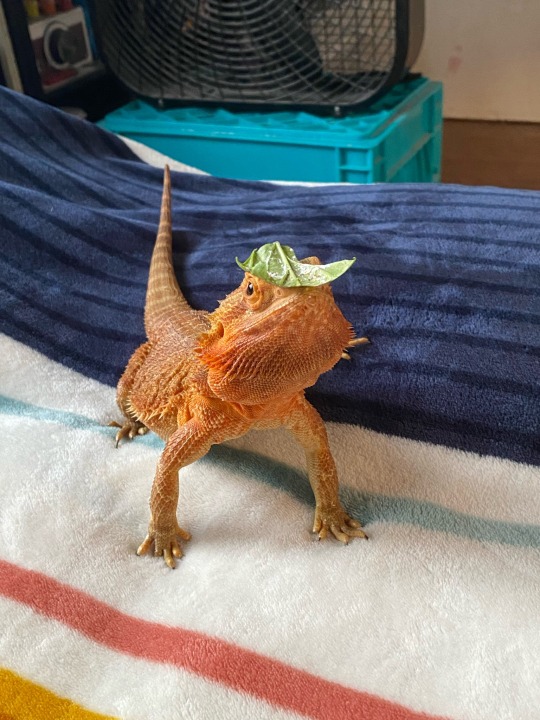
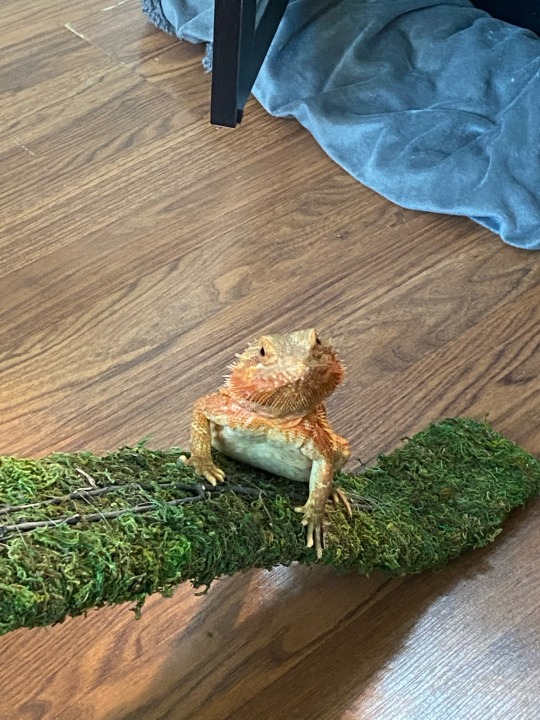


#MikeyMoment#appreciate a dragon day#bearded dragon#Pogona vitticeps#herpetology#herpetofauna#herptiblr#herptiles#reptiles#reptiblr#reptile keeper
21 notes
·
View notes
Text
Wet Beast Wednesday: Nile crocodile
Humans in general often have a fear of large reptiles. This may have an evolutionary advantage as it helped our smaller ancestors avoid large predators like snakes and crocodiles. Whatever the reason, the fear has entered into many belief systems and one common feature in many myths, legends, and religions of Africa and the Middle East is the Nile crocodile. While their reputation as man-eaters is somewhat exaggerated, Nile crocs are one of the most dangerous reptiles to humans, with only the saltwater crocodile matching them in human deaths. However, like most animals, the danger can be avoided if you know what to do and what not to do.
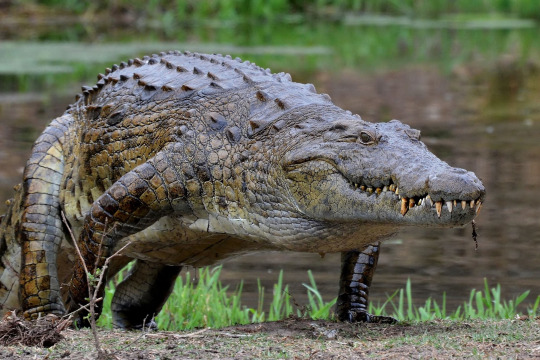
(Image ID: a Nile crocodile walking on land, seen from the front. It is a quadruped with short limbs on the side of its body, scaly skin, and an elongated set of jaws with protruding teeth. The tail is out of view. Its body is dark brown on top and yellowish on the sides. End ID)
The Nile crocodile, Crocodylus niloticus, is the second largest crocodilian and (depending on how you measure some snakes) possibly the second largest living reptile after the saltwater crocodile. Average adult males (which are larger than females) reach between 3.5 and 5 meters (11.5 to 16.5 ft) and and 255 to 270 kg (500 to 1,650 lbs), but some specimens have gotten considerably larger, with the largest confirmed size on record being a male who broke the scale at 6.45 m (21 ft) and between 1,043 and 1,089 kg (2,300 - 2,400 lbs). Nile crocodiles are fairly typical crocodilians. They are large quadrupeds with scaly skin covered with scutes and osteoderms, long and powerful jaws, and eyes, ears, and nostrils on top of their heads. Their eyes are protected with transparent eyelids called nictitating membranes and their skin has many sense organs whose purpose is poorly understood but may help detect changes in water pressure. While on land, the crocodiles are fairly slow and ungainly, but they can swim at high speeds when needed. The broad jaws and powerful muscles give the crocodiles an enormous bite force, being able to bite down on prey with 22 kilonewtons of force. For comparison, humans max out at about 0.7 kilonewtons. This force can also be continuously applies for long periods of time, allowing the crocodiles to hold struggling prey in their mouth and drag it underwater. Famously, though crocodilians can close their jaws with incredible force, the muscles for opening their jaws are much weaker and can be held shut with a person's bare hands or some duct tape. They have dark bronze scales on the back and lighter yellow scales on the sides and underbelly, marked with dark spots. The color darkens as the animal ages. As with all crocodilians, the Nile crocodile has a four-chambered heart that is highly efficient at oxygenating blood and is similar to the hearts of birds. Crocodilians and birds are actually more closely related to each other than they are to anything else still alive. All crocodilians have high lactic acid levels in their blood. This allows them to sit motionless for long periods of time, but increased levels due to overexertion can kill them.

(Image ID: a Nile crocodile resting in the water just offshore, with most of its body still visible. This one is a lighter brown. Its tail is visible. It is long and thick, with two rows of scutes running down it. Its mouth is open. End ID)
Nile crocodiles are found throughout a large portion of Africa and are the most widespread crocodiles, with only the saltwater crocodile having a wider distribution. Their current range is smaller than it used to be and now it is known that areas there were once thought to be part of the Nile croc's range are actually home to the similar species known as the West African crocodile. The West African crocodile was formerly believed to be the same species as the Nile crocodile and was only reclassified in 2011. Their habitat is freshwater lakes, waterways, and swamps throughout Africa. They can tolerate brackish or marine water, but but prefer fresh water. Like other crocodilians, Nile crocs are largely sedentary ambush predators. They can remain motionless for long periods of time, often submerged with only their eyes, ears, and nostrils exposed. A crocodile submerged like this can easily be mistaken for a log. When prey comes close, the crocodile will lunge forward and bite down. Larger prey that is not killed outright will be dragged into the water and drowned. Almost uniquely among crocodilians, nile crocodiles are known to hunt on land. They still employ ambush tactics, usually hiding in brush along paths at night and attacking animals passing by. They have even been known to try to steal kills from land predators and get into tug-of-war battles with lions over pieces of carrion. While clips of a massive crocodile leaping out of the water to drag a zebra to its doom make for entertaining documentaries, about 70% of a Nile crocodile's diet is composed of fish. As an individual grows, larger land animals will make up more of its diet. Nile crocs have been known to cooperate to herd fish into tight spots where they are easier to catch and eat. While famous for their skill and hunting and killing prey, Nile crocodiles are anything but voracious eaters. Their stomachs are pretty small for their size, only around the volume of a basketball. They can also go long periods of time between meals, sometimes several months without signs of starvation. Nile crocodiles are a classic case of apex predators. An adult Nile crocodile has no natural predators, though young ones do get attacked and eaten by larger predators, including other crocodiles. Curiously, they are known to swallow stones. Swallowing stones, known as gastroliths, it a well-known behavior in the animal kingdom. They are usually held in the digestive tract and used to help grind up tough food. Most species that use gastroliths are herbivores or omnivores who use them to help grind up tough plant matter, so it's not clear why the carnivorous crocodiles need gastroliths.

(Image ID: a nile crocodile's had visible above water. Its mouth is open and in it is a silvery fish known as a tilapia. End ID)
youtube
(Video ID: a clip from the BBC Earth showing a Nile crocodile successfully attacking a wildebeest. End ID)
When not attacking prey, Nile crocs are pretty sedentary. They can easily spend most of the day basking in the sun, behavior common to large reptiles who need a long time in the heat to warm their bodies enough to perform daily functions. While basking, they sit on land, often with their mouths open. The open mouths are vital for thermoregulation (a crocodile with its mouth sealed shut can overheat and die), but may also serve as a warning to others who may want to steal their spot. In the southernmost reach of their range, Nile crocodiles may wait out the cool, dry months of May to August by digging burrows and entering aestivation, a state similar to hibernation. Nile crocodiles are social creatures that live, bask, and hunt together. They follow a social order with the largest individual around (almost always an old male) being in charge and having first access to food and the best territory. Males are territorial and will try to force other males out of their range. Larger males will be able to maintain the best territories while smaller males are forced to live on the outskirts. Females are not territorial and will seek out the best male territories to live in. While territorial, crocs of all sizes will come together while basking and their interaction then are mostly peaceful. they are known to communicate through posturing, touch, and vocalizations. Males are known to compete over territory and while most of these competitions are settled through threat displays, they may escalate to violence.

(Image ID: four crocodiles resting on a sandy shoreline. End ID)
Territoriality is especially prominent during mating. The mating season begins around the beginning of the dry season and varies based on location. Males will signal for females with several noises, including bellowing, blowing water out of their noses, and slapping the water with their heads. Males will also attempt to drive other males away to reduce competition. When a female chooses a male, she will approach him and the pair rub their jaws together while making a warbling sound. Males like it rough, roaring and pining the females down, sometimes underwater, while mating. Most males will only mate with a single female each year, though some particularly successful males in certain regions will can multiple mates each year. After two months, the female lays her eggs. While most crocodilians incubate their eggs in piles of rotting leaves, Nile crocodiles use sandy banks or beaches. The female digs a nest, lays up to 80 eggs in it, then buries the eggs. The heat of the sun is used to incubate the eggs and to determine the sex of the offspring. Eggs incubated between 31.7 and 34.5 degrees C will be male. All others will be female. Nests used to be laid extremely close to each other, but but to increased disturbances along the nesting sites, this has become rare. During the incubation period, the mother guards the nest continuously, only leaving to avoid overheating by resting in the shade or entering the water. The father also plays a role, patrolling the area around the nest to drive away predators who would eat the eggs. Incubation lasts about 90 days and the female usually will not eat during this time. The hatchlings will make chirping noises before hatching to signal to the mother that she needs to dig out the nest. Once uncovered, the mother may use her jaws to crack the eggs and assist hatching. Hatchings start at around 280 mm (11 in) long and 70 grams (2.5 oz) and will increase by that rate for the first few years. The mother will protect her offspring for up to two years, often carrying them on her back or in her mouth or throat pouch to keep them safe from predators. The juveniles feed on insects for the first few years of life. Even after leaving their mother, hatchlings will often live in groups until they are large enough to not have to worry about predators. It is estimated that only 10% of eggs hatch and 1% of hatchlings survive to adulthood. Sexual maturity is reached at around 11 to 12 years and the maximum lifespan is estimated to be 70 to 100 years.

(Image ID: a Nile crocodile mother standing at the edge of her nest, a pit in the ground. Multiple white eggs are visible, as are newly-hatched crocodiles, which are far smaller version of an adult. End ID)

(Image ID: Nile crocodile eggs hatching. Four eggs are visible and two are actively hatching, with only the hatchling's heads having emerged. Two other crocodiles have already hatched. End ID)
Nile crocodiles are threatened by habitat loss, pollution, prey loss, bycatch, and human hunting. From the 1940s to the 60s, Nile crocodiles were hunted in massive numbers for the leather trade and were near extinction until new laws, international trade regulations, and conservation efforts largely stopped the hunting efforts. Despite this, their population has not returned to pre-hunting levels and they have been extirpated from many locations. Poaching still happens, as does hunting due to their perceived status as man-eaters, which is actively hindering conservation efforts. Like with sharks, the public image of an animal as being dangerous to humans directly harms its survivability and conservation efforts. Loss of habitat and suitable nesting sites due to damming and other human-caused changes to wetlands have also damaged crocodile populations. An invasive plant, Chromolaena odorata, is harming the crocodiles due to it growing out of control in nesting grounds. The shade from the plants keeps the sun from warming the eggs, causing them to die. Nile crocodiles and saltwater crocodiles are responsible fro the vast majority of attacks on humans and it is estimated that Nile crocs may be responsible for hundreds of deaths (most of them unreported) a year. Only the largest individuals pose a threat to adult humans, though children are at risk to smaller crocs. In fact, Nile crocodiles kill more humans per year through direct attacks than any other wild animal. Those numbers are still dwarfed by deaths due to disease spreading animals, animals acting in self-defense, or attacks or injuries from domesticated animals. For the most part, the crocodiles do not seem to target humans, the number of attacks comes from humans and the crocodiles both living near the water's edge and the crocodiles' nature as generalist predators of large animals. People who study and interact with the crocodiles report that if the right precautions are taken, the danger from being around the animals is negligible and many people and groups have tried to spread safety precautions, especially to poor and remote areas where attacks are likely the most common.

(Image ID: several juvenile Nile crocodiles in a tank being fed. Someone is using a grabber on a stick to drop meat into the tank. Four of the crocodiles are rearing out of the water to get the food. End ID)
#oh yeah wet beast wednesday#nile crocodile#crocodile#crocodilian#herpetology#herpetofauna#herptiles#herptiblr#reptile#reptiblr#rebog
22 notes
·
View notes
Text

4K notes
·
View notes
Text

Serenity
Yacare Caiman with an unidentified butterfly atop its head (Caiman yacare)
Photo Credit
#Yacare Caiman#Caiman yacare#crocodillian#caiman#herpetology#herpetofauna#herptiles#herptiblr#reptiles#reptiblr#wildlife#wildlife photography#I rlly like this picture
193 notes
·
View notes
Text
Woaah that’s crazy! I didn’t know these guys were secretly spikey! Very neat :D
What a DORK❗️

#so you do learn something new everyday#herpetology#herpetofauna#herptiblr#amphibians#amphiblr#rebog
10K notes
·
View notes
Text
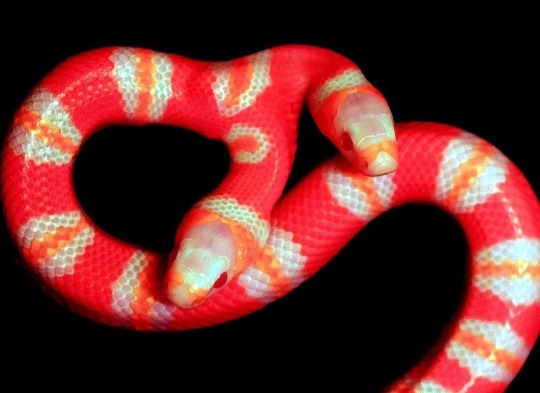
Seeing Double
Two-headed Albino Honduran Milk Snake (Lampropeltis triangulum hondurensis)
Photo credit
#Honduran Milk Snake#Lampropeltis triangulum hondurensis#snakes#herpetology#herptiblr#herpetofauna#herptiles#reptiblr#reptiles#albino animals#wildlife#wildlife photography#I rlly like this picture
8 notes
·
View notes
Text
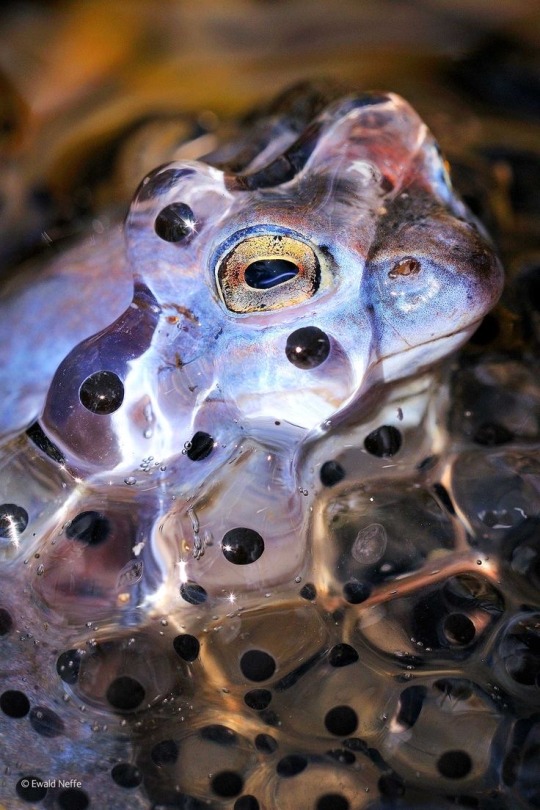
Eye of the Spawn
Moor Frog (Rana arvalis)
Photo credit
#Moor Frog#Rana arvalis#frogs#herpetology#herptiblr#herpetofauna#herptiles#amphibians#amphiblr#amphibian#wildlife#wildlife photography#I rlly like this picture
10 notes
·
View notes
Text
What a DORK❗️

#now this is a real silly fella#Bahia's broad-snout casque-headed tree frog#Nyctimantis arapapa#sillyposting#if ya like this post you should check out the stuff I put actual effort into lol#frogs#herpetology#herptiblr#herpetofauna#herptiles#amphibians#amphiblr
10K notes
·
View notes
Text
The ‘mander is a good contender, but dare I say I may have a runner-up in the “most creature ever” league ↓

Meet the Turtle Frog (Myobatrachus gouldii)
Photo credit
Can I show you my contender for most creature ever?
#this is such a creature#Turtle frog#herpetology#herpetofauna#herptiblr#herptiles#amphibians#amphiblr#rebog
27K notes
·
View notes
Text
There were a lot of freshwater mussels on the 2021 US extinction list. They didn’t leave us with haunting recordings of them calling out for a mate they’d never meet, there were no drawings in vivid color. They were extremely important nevertheless and their loss is frustrating too. That’s why stream ecology and mollusks have always fascinated me. They were silent, stalwart little heroes and entire species were lost to pollution.
#not a herp#but think about all of the extinct species that go forgotten because they are seen as less appealing to human comforts and opinions#so many forgotton creatures without voices :(#wildlife conservation#rebog
80K notes
·
View notes
Text
[ Edit: This new series will begin February 1st, 2024! ]
Heya everyone!
I need some help deciding which direction to take our Herptile of the Week segment in!
Option A.) Herptile of the Week becomes Herptile of the Day! This option would include one post per day regarding a particular herptile with each day being focused on a new herp! The post would entail similar content as to what has already posted in the past for the segment, including valuable details about the species and any interesting facts or studies regarding them that I come across during my research and much more! I would also like to include a little drawing of our chosen herp, done by me, with each post! :D
Option B.) Herptile of the Week would stay relatively the same as to how it already was, except posts will be less frequent, with one post every other day rather than everyday. We would still focus on one herp every week, with each post focusing on a different topic, but there would be less content overall. A drawing at the end of the week of the chosen herp will possibly also be included, but that would depend on timing and other stuffs :)
Option C.) Suggest a different solution! If you have any other ideas on how to format Herptile of the Week/Day(?) please feel free to send it to my ask box!
#Herptile of the Week#herpetology#herptiblr#herpetofauna#herptiles#reptiblr#reptiles#amphibians#amphiblr#animals#animal education#wildlife#wildlife education#wildlife science#educational#zoology#science
2 notes
·
View notes
Text
Sharks, orcas, wolves, mongooses, hawks, owls, eagles, big cats, snakes, piranhas, centipedes, preying mantises, scorpions, spiders, squids, komodo dragons, polar bears, sea lions, crocodilians: entire groups of life adapted to eat absolutely nothing but the raw flesh of other creatures. Our society recognizes all of these as iconic killing machines. They all occupy a position in our collective consciousness that teeters between majestic warrior hunter and grim terrifying murder monster. Embodiments of nature's ferocity. Agents of death.
Frogs: an entire group of life adapted to eat absolutely nothing but the raw flesh of other creatures. We think they're silly guys who ought to wear floppy hats perhaps
#frogs are just too silly looking!#there are some real freaky lookin’ ones though ^^’#herpetology#herptiblr#amphiblr#amphibians#rebog
6K notes
·
View notes
Text
I made some oatmeal raisin cookies with a friend last night and we had a lot of extra dough after making two batches already, sooo I decided to do something different with the leftovers…
I present to you the oatmeal raisin snake!
Before cooking the boy ↓

After he baked ↓
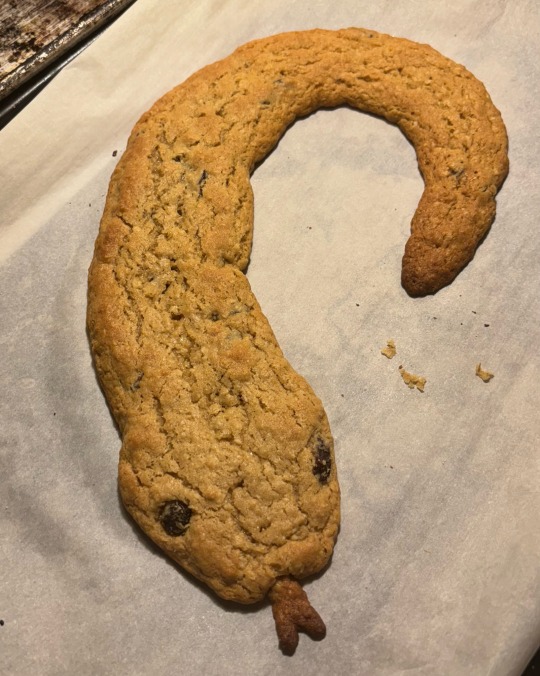
He turned out very cute and very yummy! :D
#I rlly like how he turned out even though his creation was a massive joke#I thought he was gonna explode in the oven tbh#sillyposting#snakes#herpetology#baking#oatmeal raisin cookies
21 notes
·
View notes
Text

Hidden
Vietnamese Mossy Frog (Theloderma corticale)
Photo credit
#Vietnamese Mossy Frog#Theloderma corticale#frogs#herpetology#herpetofauna#herptiles#herptiblr#amphibians#amphiblr#wildlife photography#I rlly like this picture
4 notes
·
View notes